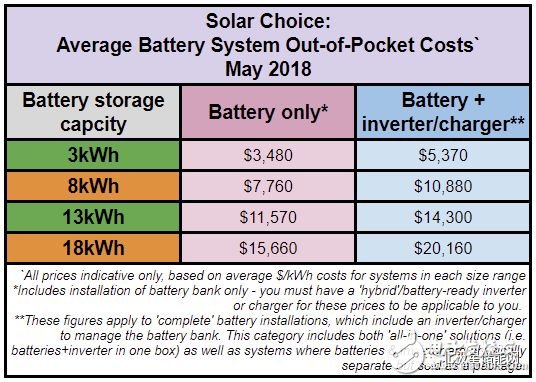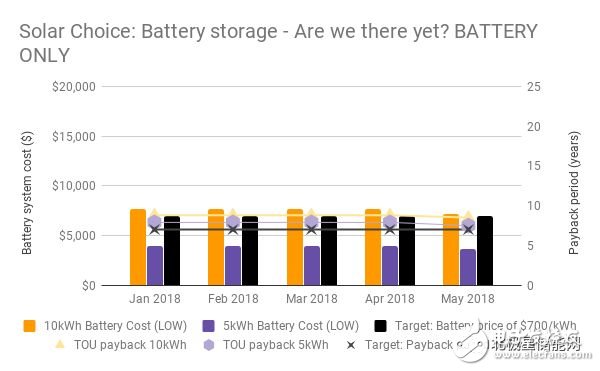Australia has the highest rooftop PV coverage in the world, making Australia the hottest area for household energy storage in the world. Since 2012, battery storage capacity has increased year after year, but in fact only 25,000 to 35,000 of the two million PV users have installed battery equipment, which is less than 2%.
The battery just looks good?
Various reports have made Australia's household battery storage look promising, but there is still some controversy about whether to install a battery.
Photovoltaic prices are reasonable (close to $1/W, an average of $0.70/W in a 5kW system in most parts of the country)
Photovoltaic is very common (the number of PVs exceeds the population in 2016)
Photovoltaic power generation costs less than half of the retail price of electricity (10c/kWh vs 25c/kWh)
Australians are reluctant to accept power retailers (dislike power bills)
This is why Tesla and Enphase decided to launch a household battery plan here, and other companies including LG Chem/BYD are also rushing to join.
Why is there not a lot of installation?
Why are Australians not installing battery storage in large quantities? The main reason is cost.
For residential grid-connected batteries, the price of a $1/kWh lithium-ion battery is still a bit expensive.
The capital cost of installing batteries is often higher than what most households think is reasonable or affordable, especially if some of them have already spent thousands of dollars on solar PV systems. Although they can minimize these costs by choosing smaller batteries, smaller battery packs tend to have higher costs. To the best of our knowledge, the lowest reasonable cost for the smallest commercial battery is approximately $2,000 to $3,000 per 1.2kWh in-phase AC battery.
The economics of batteries increase with the expansion of scale. The cost per kWh of large batteries tends to be lower, and the return on investment is shorter than that of small batteries (of course, the premise of small batteries is to meet the energy needs of households). Therefore, families with cost budgets may give up installing batteries.
In short, many Australians who want a battery can't afford (or don't want to pay for it) a large battery that is good enough to provide the most favorable return.

Since November 2017, the price per kWh of Australian battery (including frequency converter) systems has been divided into three ranges. Although they all show a gradual downward trend, they are still far from the target of less than $1,000/kWh.
What are the application modes of battery storage?
When Australian residents are ready to purchase battery storage, there are two basic modes to consider: a battery retrofit in an existing PV system, or a new PV system with a battery installed.
In general, the economics of a retrofitted battery system is not as good as a new solar energy storage combination system. The main reason for this is the cost of the equipment; retrofitting usually requires the replacement of a frequency converter, an additional inverter or a full-cell inverter. And because older systems are mostly 1.5-3 kW, and today's standards are 4-6 kW, this requires an additional increase in PV system capacity. All of these reasons have pushed up costs.
It is still quite rare to retrofit small batteries to modern solar systems with battery-ready inverters, as the number of batteries of this type is still small and is likely to be installed only in the past few years. During this period, the battery price has changed, but the change has not occurred too much.
In contrast, the new solar + energy storage system, which includes solar inverter costs, can be upgraded to a "hybrid" system with batteries for hundreds of dollars. In this case, the battery can be plugged directly into the system without the need for additional equipment and labor. This is the fastest way to return the cost of battery storage.
Comparison of price between pure battery and battery + inverter
Specifically, the new solar + energy storage system using hybrid inverter will be the most sensible way to consider the cost in the future, especially the scale of the solar system network, which is increasingly determined by the size of the inverter. This means that dual inverter solutions, such as Tesla powerwall 2, sonnen eco or Enphase AC Batteryv, are not as good as a single new solar energy storage system solution, although their price is higher and the return period is longer. Of course, both solutions have their own meaning, and it is necessary to distinguish between the two options when studying pricing.

In Australia, the average cost of a battery system by size, category, and type (ie, battery only and battery-containing inverters). Image courtesy of the battery energy storage price index offered by PV in May 2018.
Battery storage rate analysis
The chart below, which is the best solution for connecting energy storage in the Australian grid, tracks the cost of the "pure battery" system during pricing and cost-return. The chart does not include the costs and benefits of the PV system itself.
Although the battery price "low point" for such systems has not changed significantly since the start of tracking, it has been seen that the payback period is close to 7 years, and some products with a capacity of 5 kWh are already below $5,000. In this sense, we can say that battery storage is more or less the desired goal, at least in the "best case", but it may also vary greatly from city to city.

Here is just an overview of some of the high-quality battery pricing in Australia. In fact there are many things - not discussed in depth, including such things as electricity price arbitrage (for example, weather-based smart battery pre-charging) and other power companies provide auxiliary benefits. All of this gives the battery a good prospect for future applications. Over time, as the grid becomes more intelligent and decentralized, batteries will become more common.
Detachable Laptop Stand,Foldable Detachable Computer Stand,Detachable Ergonomic Laptop Stand,Detachable And Foldable Aluminum Laptop Stand
Shenzhen ChengRong Technology Co.,Ltd. , https://www.dglaptopstandsupplier.com